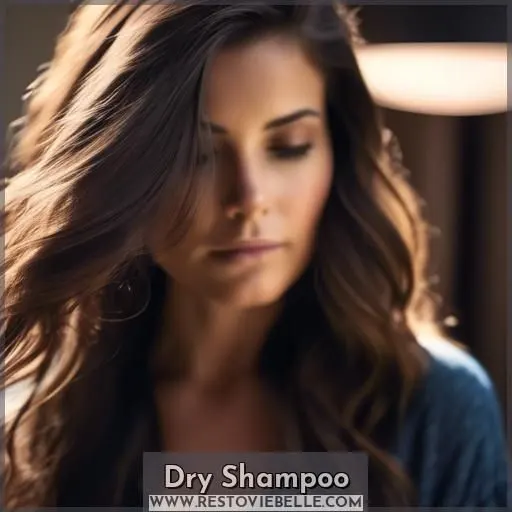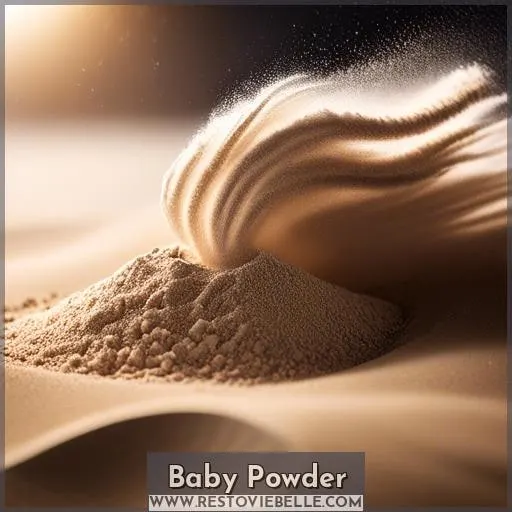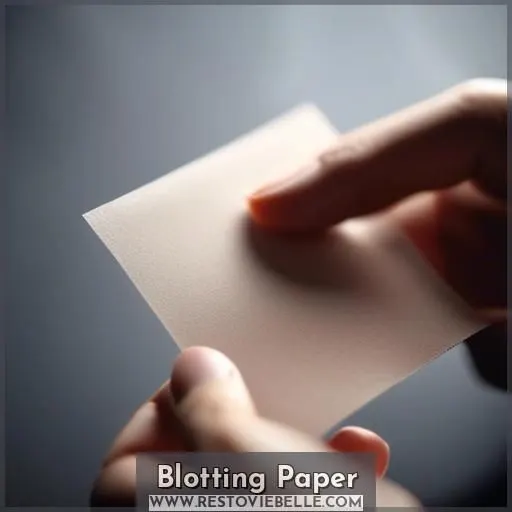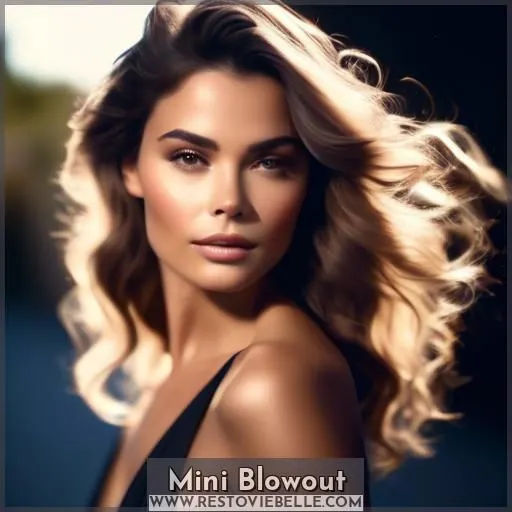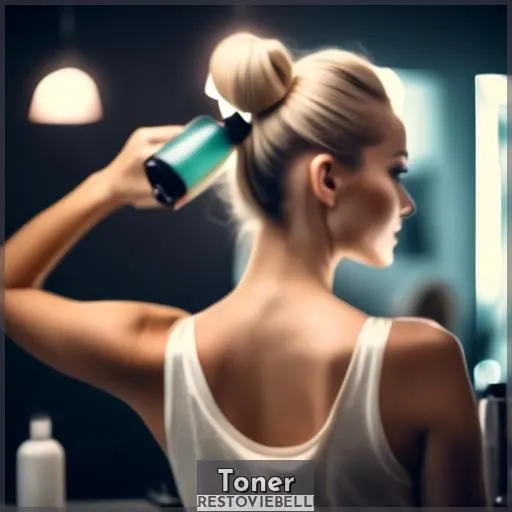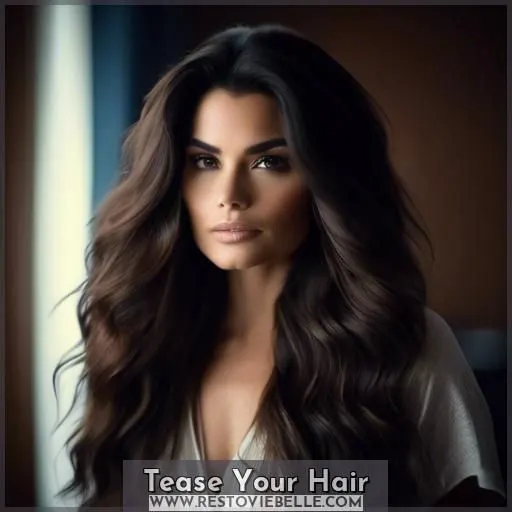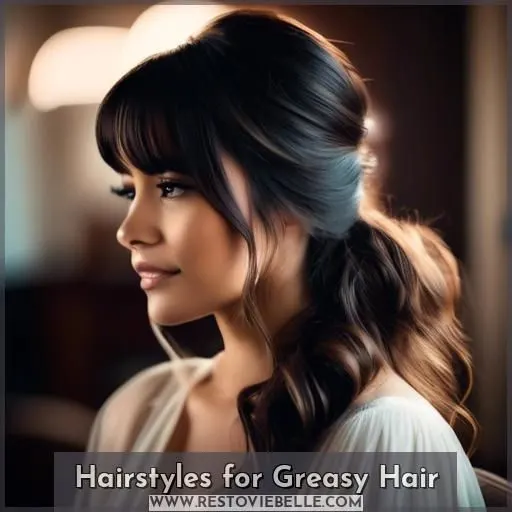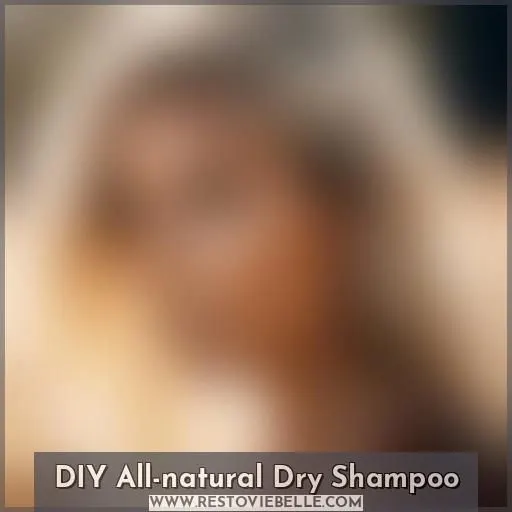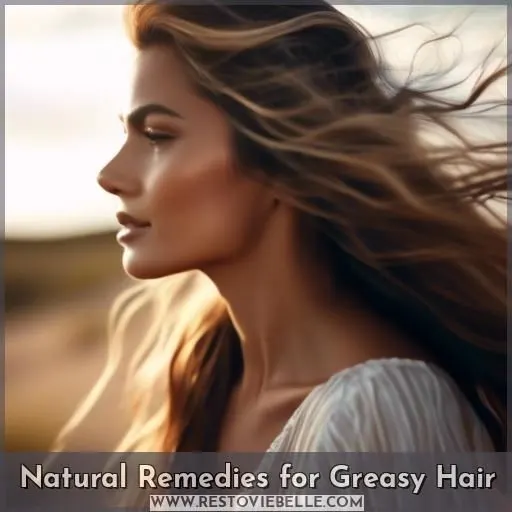This site is supported by our readers. We may earn a commission, at no cost to you, if you purchase through links.
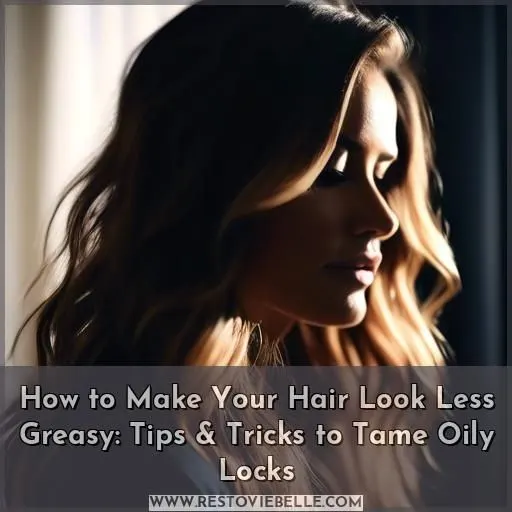
You can make your hair look less greasy by using dry shampoo or baby powder to absorb excess oil at the roots.
Blotting papers also help soak up grease on-the-go.
For a quick fix, try a mini blowout – apply dry shampoo, blow-dry with a round brush, and set with Velcro rollers.
Toners formulated for greasy hair can help regulate oil production when massaged into the scalp.
Beyond products, teasing hair at the roots adds lift and masks oiliness.
If you’re seeking natural solutions, explore home remedies that harness ingredients like cornstarch, lemon juice, and apple cider vinegar for fresh, vibrant locks.
Table Of Contents
Key Takeaways
- Use dry shampoo or baby powder to absorb excess oil at the roots.
- Try a mini blowout for a quick fix, applying dry shampoo, blow-drying with a round brush, and setting with Velcro rollers.
- Consider using toners formulated for oily hair to regulate oil production when massaged into the scalp.
- Experiment with natural solutions like cornstarch, lemon juice, and apple cider vinegar for fresh, vibrant locks.
How to Make Your Hair Look Less Greasy?
To make your hair look less greasy, you can use a round brush to blow-dry your hair, focusing on areas like your forehead. This will help increase volume and reduce the appearance of oiliness. Another option is to use a toner, which can contain alcohol to quickly absorb oil and give your hair a fresher look. Additionally, you can tease your hair by dividing it into small sections and using hairspray to add bounce and volume. If these methods aren’t enough, you can try using home remedies like baking soda or multani mitti, which can absorb oil and dirt, or DIY dry shampoo made from cocoa powder, cornstarch, or baby powder. Remember to avoid vigorous drying, which can irritate your scalp and increase oil production, and choose products designed to mitigate greasy hair.
Dry Shampoo
Let’s venture into the realm of dry shampoo, your secret weapon against oily hair. Picture this: you’re running behind schedule, and your hair’s slicker than a greasy spoon’s breakfast platter.
Enter dry shampoo, the savior you never realized you needed. It’s not just a hasty solution; it’s a way of life for those seeking control over their tresses.
With homemade dry shampoo alternatives like cornstarch or talcum powder, you’re not just rescuing your hair; you’re embracing liberation. Blend a touch of cornstarch with a few drops of essential oil, and presto, you’ve created a homemade dry shampoo that can rival any commercial product.
It’s hair care, hair styling, and a touch of magic all in one. So, the next time your hair’s acting up, remember, a quick spray can subdue even the most unruly strands.
Baby Powder
Baby powder is a versatile and affordable option for managing greasy hair. It’s a popular choice for those needing a quick fix or whose dry shampoo is depleted. Here’s how to use baby powder to maintain the appearance and feel of clean hair for an extended period:
- Choose the right baby powder: Select a talc-free and fragrance-free option to avoid scalp irritation. Cornstarch-based baby powders are a good choice as they’re gentle and absorbent.
- Apply the baby powder: Wash your hands thoroughly to remove any oils that could transfer to your hair. Then, shake a container of baby powder over the palm of your hand three times. Rub your hands together to disperse the product. Use your hands to massage the baby powder into the roots of your hair, concentrating on the crown and behind the ears, as these areas produce the most oil.
- Brush your hair: After applying the baby powder, brush your hair from root to tip with a natural-bristle brush. The stiff fibers of a natural-bristle brush will help to coat your hair evenly in baby powder, enabling it to absorb the powder and create volume.
- Consider your hair color: Baby powder works best on light hair, but those with dark hair will need to spend extra time working it into the root to blend or opt for a tinted dry shampoo instead.
Blotting Paper
Blotting paper is a highly absorbent type of paper that can be used to remove excess oil from the skin. It’s a convenient and portable solution for those who want to keep their skin matte and fresh throughout the day. Here are some tips on how to use blotting paper effectively:
- Selection of Blotting Paper: Choose a high-quality blotting paper that’s made from natural fibers, such as cotton. This guarantees that the paper is highly absorbent and gentle on the skin.
- Application: Gently press the blotting paper against the oily areas of your face, such as the T-zone. The paper will absorb the excess oil, leaving your skin with a more matte appearance.
- Disposal: Once the blotting paper is full, dispose of it in the trash. It’s important not to reuse the paper, as this can spread bacteria and cause skin irritation.
If you have oily skin, blotting paper can be a useful tool to help control shine and keep your skin looking fresh. It’s especially helpful when you’re on the go and can’t wash your face. Blotting paper is also a more convenient alternative to using powder-based products, which can leave a cakey finish on the skin.
Mini Blowout
Mini blowouts can be a game-changer for those with greasy hair, especially after a workout or a day spent in the sun. This quick and easy styling technique can help you achieve a fresh, volumized look without the need for a full-blown blowout. Here’s how to do it:
- Dry shampoo: Start by applying dry shampoo to your roots. This will help absorb excess oil and add some texture to your hair.
- Sectioning: Divide your hair into small sections, making it easier to work with.
- Round brush: Use a round brush to blow-dry your hair, starting from the roots and working your way down. This will help create volume and lift at the crown.
- Roller: After blow-drying, use a large Velcro roller to set your hair. This will help you achieve a smooth, polished look.
- Heat styling: If you have curly hair, you can use a round brush and hairdryer to smooth out your curls, creating a sleek ponytail or a bouncy blowout.
Toner
Toner for Greasy Hair: Tips and Tricks
If you’re dealing with greasy hair, you might be wondering if toner can help. While toner is most commonly used to alter the tone of blonde hair, it can also be used to address greasiness. Here are some tips on how to use toner for greasy hair:
- Choose the right toner: Opt for a toner specifically designed for greasy hair or one that contains ingredients that help absorb excess oil. Some popular options include witch hazel, which absorbs excess oil, and baking soda, which can help remove buildup and balance the scalp’s pH.
- Apply the toner: Apply the toner to your scalp and massage it in gently. This will help the toner absorb excess oil and leave your hair looking less greasy.
- Rinse and condition: After applying the toner, rinse your hair thoroughly to remove any excess product. Follow up with a gentle conditioner to keep your hair hydrated and healthy.
- Use toner as needed: Depending on your hair type and the level of oiliness, you may need to use toner daily or only a few times a week. Experiment with different application frequencies to find what works best for your hair.
- Combine toner with other treatments: If your greasy hair is also prone to dandruff or scalp irritation, consider using a scalp toner that addresses these issues as well. Look for toners that contain ingredients like witch hazel, menthol, or tea tree oil, which can help soothe and protect the scalp.
Remember that toner is just one part of a detailed hair care routine. To keep your hair looking its best, make sure to wash it regularly, avoid overwashing, and use gentle, sulfate-free shampoos and conditioners. Additionally, consider using dry shampoo between washes to absorb excess oil and add volume to your hair.
Tease Your Hair
After using a toner to manage that slick, greasy look, let’s pump up the volume with some savvy teasing techniques. You’re not just adding oomph; you’re taking control and showing that oil who’s boss.
- Start at the roots, where hair tends to lie flat, and use a teasing brush for precision.
- Gently backcomb small sections at a time to build a foundation of hair volume without going overboard.
- Remember, it’s a tease, not a tangle-fest—be kind to your locks.
- Smooth over the top layer to conceal the structured chaos beneath, achieving a look that’s both voluminous and polished.
A little lift at the roots can work wonders, transforming greasy-look dread to head-turning cred. Keep it light-hearted, and your hair will stand tall, just like your spirits.
Home Remedies to Get Rid of Greasy Hair
If you’re tired of your greasy hair and want to avoid washing it every day, there are several home remedies that can help.
One popular solution is a baking soda scrub. Mix a tablespoon of baking soda with a little water to create a paste, then gently massage it into your scalp. Rinse it out thoroughly and follow with your usual shampoo and conditioner.
Another option is a cornstarch mask. Mix a tablespoon of cornstarch with a little water and apply it to your roots. Let it sit for 10-15 minutes, then rinse it out.
For those with oily hair, a lemon juice rinse can be effective. Mix equal parts lemon juice and water, then apply it to your scalp. Leave it on for a few minutes before rinsing it out.
Finally, rice water rinses can help balance the pH of your scalp and reduce oil production. To make a rice water rinse, soak rice in water overnight, then strain the water and use it as a final rinse after shampooing.
These home remedies can help you manage your greasy hair without constantly washing it.
Hairstyles for Greasy Hair
In terms of hairstyles for greasy hair, there are a few reliable options that can help you achieve an optimal appearance and well-being.
A prevalent option is the unkempt bun. This style is ideal for those instances where you need to keep your hair away from your face without addressing the greasiness. Simply gather your hair into a loose bun, securing it with a hair tie or bobby pins.
Another alternative is the headband braid. This style entails braiding your hair while wearing a headband, which can assist in absorbing some of the excess oil.
For a more refined look, consider a sleek ponytail. This style can be achieved by brushing your hair backward and securing it with a transparent elastic.
Lastly, if you’re feeling bold, a top knot or French braid can impart texture and volume to your hair while simultaneously concealing any greasiness.
DIY All-natural Dry Shampoo
Regarding greasy hair, there are several techniques you can employ to minimize its oily appearance. One such technique involves creating a homemade, all-natural dry shampoo. This can be formulated using components such as cornstarch or baby powder, which effectively absorb surplus oil from your scalp.
To create your own DIY dry shampoo, you may utilize a straightforward recipe that incorporates cornstarch and a few drops of essential oil for fragrance, if preferred. Simply combine the ingredients and store them in a container of your choice. For application, sprinkle the powder onto the roots of your hair and massage it in using your fingertips. Allow it to remain for a few minutes to absorb the oil, then brush it through your hair until it becomes invisible.
Alternatively, you may use baby powder as a substitute for dry shampoo. Baby powder has oil-absorbing properties and a subtle scent, making it a suitable option for individuals seeking to avoid the additional ingredients present in some commercial dry shampoos. To utilize baby powder as a dry shampoo, simply sprinkle it onto your scalp and massage it in with your fingertips. Apply more as necessary, but begin with a small amount to prevent your hair from appearing white.
Natural Remedies for Greasy Hair
If you’re seeking all-natural remedies to tackle greasy hair, you’re in luck! There are various home-based solutions that can assist you in controlling your oily locks. Let’s explore some of these remedies:
- Baking Soda Paste: Mix baking soda with water to form a paste. Apply it to your scalp, let it rest for a few minutes, and then rinse it off. This can aid in absorbing excess oil and leave your hair looking less greasy.
- Cornstarch Mask: Cornstarch can be utilized as a homemade dry shampoo alternative. Mix it with a bit of water to create a paste, apply it to your roots, and let it rest for a few minutes before rinsing it off. This can help absorb oil and give your hair a matte finish.
- Aloe Vera Gel: Aloe vera is renowned for its soothing properties. Apply some aloe vera gel to your scalp and massage it in. This can help remove excess oil and leave your hair looking fresh and clean.
- Lemon Juice Rinse: Lemon juice can assist in balancing the pH of your scalp and reducing oil production. Mix lemon juice with water and use it as a final rinse after shampooing. Be cautious not to use too much, as lemon juice can be drying.
- Rice Water Rinse: Rice water is rich in vitamins and minerals that can help strengthen your hair and reduce oiliness. Rinse your hair with cool rice water after shampooing.
Frequently Asked Questions (FAQs)
Can certain hairstyles exacerbate greasiness?
Definitely, certain hairstyles can make greasiness worse. Tight updos and slicked-back styles expose more scalp area, instantly revealing oily roots. Opt for looser, textured ‘dos that add volume and camouflage greasy spots.
Does hard water affect hair oiliness?
Oh, the irony of hard water ironically making your hair look greasier! This mineral-rich H2O leaves behind residue that clogs pores, trapping oils and giving your locks that undesirable slick sheen. But fear not, there are solutions to reclaim your voluminous, healthy ‘do.
Are there hormonal factors behind greasy hair?
Absolutely, hormonal imbalances can absolutely cause greasy hair. During puberty, pregnancy, or menopause, hormonal shifts influence oil production. You may battle extra grease until levels normalize. Don’t stress – with a few hair care tweaks, you’ll beat the sebum slick!
Can allergies contribute to scalp oil production?
You bet, allergies can definitely cause excess oil. If you’ve got an undiagnosed allergy, your body reacts by ramping up sebum production to protect the scalp. A vicious greasy cycle, but pinpointing and managing the allergy can break it.
Does air pollution impact hair greasiness?
You bet – air pollution can indeed contribute to greasy hair. Those microscopic particles cling to strands, disrupting your scalp’s natural oil balance. While good ol’ shampooing helps, using a clarifying rinse regularly is the real gamechanger for city slickers.
Conclusion
Ultimately, managing your hair’s oiliness is an odyssey of trial and error.
You’ll need to experiment with various techniques – from dry shampoo and blotting papers to teasing and home remedies – to find the perfect balance for how to make your hair look less greasy.
Embrace your hair’s unique texture, and don’t be afraid to get creative with hairstyles or DIY solutions.
With patience and persistence, you can achieve fresh, vibrant locks that radiate confidence.
